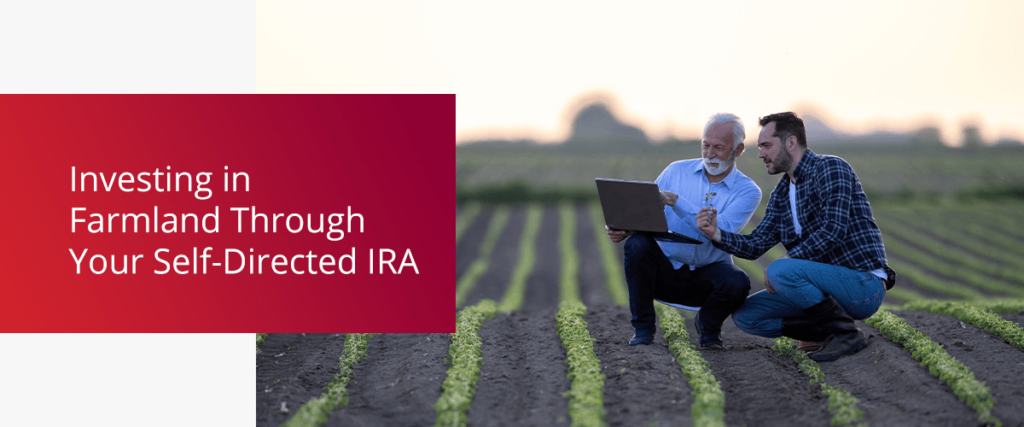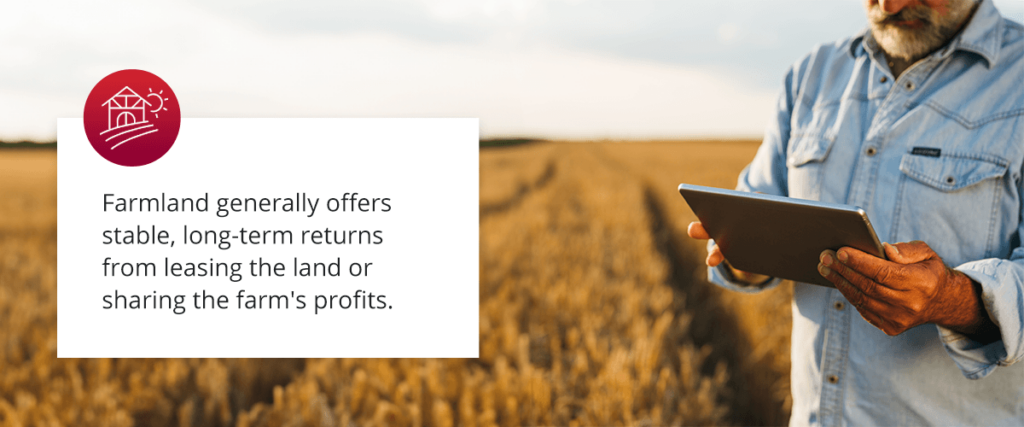
One of the best ways to invest in farmland is through a self-directed individual retirement account (SDIRA). This type of account gives investors more control over their retirement savings by allowing them to invest in alternative assets, such as real estate.
This guide explains more about real estate and farmland investments, including tax advantages and how to structure your investment.
Exploring Farmland as an Investment
You can invest in agriculture in several ways. With some investment vehicles, you don’t even need to buy a farm, such as agricultural, stocks, mutual funds and exchange-traded funds (ETFs). However, investing in farmland in an IRA gives you more control and could mean steadier returns compared to the stock market.
Focusing on agricultural land, you can choose from irrigated or nonirrigated cropland, pastureland, and developed farm properties with buildings and other structures.
Benefits of Investing in Farmland
Investing in farmland can offer several advantages compared to traditional investments. Like other real estate investments, farmland isn’t correlated with the stock market, which hedges your investment against inflation and makes it less volatile than other asset types.
Farmland generally offers stable, long-term returns from leasing the land or sharing the farm’s profits. You may also make a significant return if you sell the land since real estate generally appreciates over time.
You’ll also invest in something you understand and know will be in demand. As the world population increases, agricultural production must increase to meet growing needs.

Farmland Values and Investment Returns
Several factors influence a farm property’s value:
- Location
- Soil quality
- Agricultural trends
- Market demands and fluctuations
- Climate and weather-related issues
According to a survey from the United States Department of Agriculture, the 2023 nationwide average value of cropland was $5,460 per acre, up 8.1% from the previous year. Pastureland increased more modestly, from $1,650 per acre in 2022 to $1,760 in 2023. Even if you aren’t interested in selling your farmland, you can still see modest returns from rent. In 2023, irrigated cropland was rented for $237 per acre per year on average.
While these are lower returns than the stock market, investing in real estate is also lower risk.
How to Invest in Farmland Through a Self-Directed IRA
You can invest in farmland through any type of SDIRA. As with standard IRAs, you can choose a traditional IRA or a Roth IRA, which offer different tax benefits.
With a traditional IRA, you invest pre-tax dollars and can often deduct your contributions from your income, saving you money on taxes in the years you contribute. You won’t pay taxes until you withdraw funds, which are considered ordinary income. Conversely, you fund a Roth IRA with post-tax money, so the funds grow tax-free, and you won’t pay taxes on gains or distributions.
A Checkbook IRA is a type of SDIRA that owns a limited liability company (LLC), so it’s also called an SDIRA LLC. As the LLC manager, you handle the money in the company’s checking account, providing even more control over your IRA funds. SDIRA LLCs can be in traditional or Roth IRAs.
If you’re self-employed, you can also invest through a Simplified Employee Pension IRA (SEP IRA), which small businesses often use as an alternative to a 401(k). These funds are tax-deferred, and only the employer can contribute.
Legal Considerations and Restrictions
The most significant legal restriction to keep in mind is that you can’t directly or indirectly benefit personally from your investment, and neither can disqualified persons — your spouse, parents, children and grandchildren. This restriction means you can’t buy property and farm it yourself, but you can purchase farmland and lease it to a third party.
However, the third party doesn’t need to be a stranger. You can sell or lease farmland to extended relatives, such as a sibling or cousin, or to a friend or neighbor, as long as all transactions go through your IRA. If you handle any funds personally, the IRS may disqualify your transaction, and you could have to pay taxes and fines for withdrawing funds from the IRA early.
Purchasing Farmland With an IRA
Buying farmland with an SDIRA is similar to other real estate purchases.
The first step is to identify one or more agricultural properties that interest you. A real estate professional can help you with market analysis and due diligence to determine which property might be best for your investment goals.
The exact process for funding your investment may vary depending on your account custodian. Generally, you’ll direct your IRA administrator to transfer money from your IRA to purchase the property. With Accuplan, you need to fill out a Direction of Investment form to fund your farmland investment.
Structuring Your Investment
Your IRA can purchase farmland directly, simplifying management. However, this approach may make adhering to IRS regulations more difficult. Forming an LLC can provide more management flexibility and limit your personal liability. Titling the land in the name of an LLC can reduce IRA management fees if your LLC owns all your assets instead of the IRA having direct ownership. An LLC can also make transferring assets after you pass easier since your heirs won’t need to retitle the land.
You can also partner with more experienced investors or agriculture experts to distribute the risk and leverage their expertise. One way to join such a partnership is by investing in a farm real estate investment trust (REIT). With a REIT, the trust owns the property, and your IRA owns shares in the trust and receives dividends from the income-producing property.
While you won’t have to pay taxes individually on the income your farmland generates, your LLC may be required to pay some taxes. Income from many types of farming operations is tax-exempt. However, if your farmland generates other income, it may owe unrelated business income tax (UBIT). It’s best to consult with your tax advisor to understand how UBIT relates to your investment and get strategies to reduce your tax liabilities.
Contact Accuplan to Invest in Farmland
Investing in farmland through an SDIRA can be an excellent way to diversify your portfolio and potentially get steadier returns. If you’re interested in opening an SDIRA to invest in real estate and other alternative assets, Accuplan Benefits Services is here to help.
Our experts have many years of experience in the retirement account industry. They are passionate about helping investors understand their self-directed account options and ensuring compliance with IRS rules. We manage over $2 billion in assets and offer world-class services. Reach out for personalized assistance, or create an account to get started today.

Our information shouldn’t be relied upon for investment advice but simply for information and educational purposes only. It is not intended to provide, nor should it be relied upon for accounting, legal, tax or investment advice.